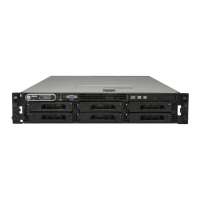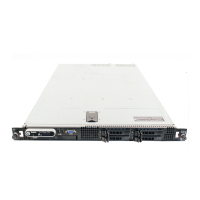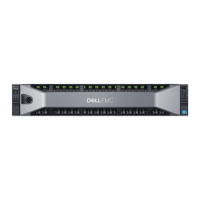Installing and Configuring SCSI Drivers 3-3
Basic Host Adapter Settings
The basic host adapter settings are the SCSISelect set-
tings most likely to require modification.
• HOST ADAPTER SCSI ID. This option sets the host
adapter’s SCSI ID. The default setting is SCSI ID 7,
which allows the host adapter to support narrow
SCSI devices in addition to wide SCSI devices. Dell
recommends that you leave the host adapter set to
SCSI ID 7.
• SCSI PARITY CHECKING. This option determines
whether the host adapter verifies the accuracy of data
transfer on the SCSI bus. The default setting is
ENABLED. You should disable SCSI PARITY CHECK-
ING if any SCSI device connected to the host adapter
does not support SCSI parity; otherwise, leave it
enabled. Most SCSI devices support SCSI parity. If
you are unsure if a device supports SCSI parity, con-
sult the documentation for the device.
• HOST ADAPTER SCSI TERMINATION. This option sets
termination on the host adapter. The default setting
for all Adaptec 78xx series host adapters is LOW ON/
HIGH ON. Dell recommends that you leave this
option set to the default.
Boot Device Settings
The boot device settings allow you to specify the device
from which to boot your computer.
• BOOT TARGET ID. This option specifies the SCSI ID
of the device from which you wish to boot your sys-
tem. The default setting is SCSI ID 0. The SCSI ID
selected here must correspond to the ID configured
on the boot device.
• BOOT LUN NUMBER. If your boot device has multiple
logical unit numbers (LUNs) and MULTIPLE LUN
SUPPORT is enabled (see “Advanced Host Adapter
Settings” found later in this section), this option
allows you to specify a particular LUN from which
to boot on your boot device. The default setting is
LUN 0.
SCSI Device Settings
The SCSI device settings allow you to configure certain
parameters for each device on the SCSI bus. To configure
a specific device, you must know the SCSI ID assigned to
that device. If you are not sure of the SCSI ID, see
“Using the SCSI Disk Utilities” found later in this
section.
• INITIATE SYNC NEGOTIATION. This option determines
whether the host adapter initiates synchronous data
transfer negotiation (sync negotiation) between itself
and the device. The default setting is YES.
Synchronous data transfer negotiation is a SCSI fea-
ture that allows the host adapter and its attached
SCSI devices to transfer data in synchronous mode.
Synchronous data transfer is faster than asynchro-
nous data transfer.
The host adapter always responds to sync negotia-
tion if the SCSI device initiates it. If neither the host
adapter nor the SCSI device initiates sync negotia-
tion, data is transferred asynchronously.
Normally, you should leave the INITIATE SYNC
NEGOTIATION setting enabled, because most SCSI
devices support synchronous negotiation and
because it allows for faster data transfer.
NOTE: Some older SCSI-1 devices do not support
sync negotiation. This may cause your computer to
operate erratically or hang if INITIATE SYNC NEGOTI-
ATION is set to YES. Set INITIATE SYNC NEGOTIATION
to NO for these devices.
• MAXIMUM SYNC TRANSFER RATE. This option sets
the maximum synchronous data transfer rate that the
host adapter supports. The host adapter supports
rates up to the maximum of 40 megabytes per second
(MB/sec). The default setting is 40 MB/SEC (the
maximum).
If the host adapter is set to not negotiate for synchro-
nous data transfer, the maximum synchronous
transfer rate is the maximum rate that the host
adapter accepts from the device during negotiation.
(This is standard SCSI protocol.)

